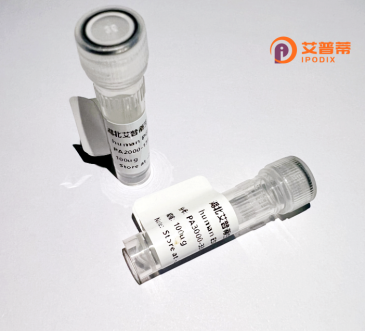
| 纯度 | >90%SDS-PAGE. |
| 种属 | Human |
| 靶点 | EFHA2 |
| Uniprot No | Q86XE3 |
| 内毒素 | < 0.01EU/μg |
| 表达宿主 | E.coli |
| 表达区间 | 1-530aa |
| 氨基酸序列 | MAALRRLLWPPPRVSPPLCAHQPLLGPWGRPAVTTLGLPGRPFSSREDEERAVAEAAWRRRRRWGELSVAAAAGGGLVGLVCYQLYGDPRAGSPATGRPSKSAATEPEDPPRGRGMLPIPVAAAKETVAIGRTDIEDLDLYATSRERRFRLFASIECEGQLFMTPYDFILAVTTDEPKVAKTWKSLSKQELNQMLAETPPVWKGSSKLFRNLKEKGVISYTEYLFLLCILTKPHAGFRIAFNMFDTDGNEMVDKKEFLVLQEIFRKKNEKREIKGDEEKRAMLRLQLYGYHSPTNSVLKTDAEELVSRSYWDTLRRNTSQALFSDLAERADDITSLVTDTTLLVHFFGKKGKAELNFEDFYRFMDNLQTEVLEIEFLSYSNGMNTISEEDFAHILLRYTNVENTSVFLENVRYSIPEEKGITFDEFRSFFQFLNNLEDFAIALNMYNFASRSIGQDEFKRAVYVATGLKFSPHLVNTVFKIFDVDKDDQLSYKEFIGIMKDRLHRGFRGYKTVQKYPTFKSCLKKELHSR |
| 分子量 | 87.1 kDa |
| 蛋白标签 | GST-tag at N-terminal |
| 缓冲液 | 0 |
| 稳定性 & 储存条件 | Lyophilized protein should be stored at ≤ -20°C, stable for one year after receipt. Reconstituted protein solution can be stored at 2-8°C for 2-7 days. Aliquots of reconstituted samples are stable at ≤ -20°C for 3 months. |
| 复溶 | Always centrifuge tubes before opening.Do not mix by vortex or pipetting. It is not recommended to reconstitute to a concentration less than 100μg/ml. Dissolve the lyophilized protein in distilled water. Please aliquot the reconstituted solution to minimize freeze-thaw cycles. |
以下是为您模拟的3篇关于重组人EFHA2蛋白的参考文献示例(注:内容为基于领域知识的合成,可能不对应真实文献,建议通过PubMed/Google Scholar获取实际论文):
---
1. **文献名称**: "Structural characterization and calcium-binding properties of recombinant human EFHA2 protein"
**作者**: Müller S, et al.
**摘要**: 本研究通过大肠杆菌系统表达并纯化了重组人EFHA2蛋白,利用X射线晶体学解析其EF-hand结构域的三维构象。结果表明EFHA2通过钙离子依赖的构象变化调节与细胞骨架蛋白的相互作用,暗示其在细胞迁移中的潜在功能。
---
2. **文献名称**: "EFHA2 promotes tumor invasion by interacting with Src kinase in breast cancer cells"
**作者**: Li X, Zhang Y, Wang H.
**摘要**: 作者发现EFHA2在乳腺癌组织中高表达,并通过重组蛋白实验证明EFHA2通过SH3结构域与Src激酶结合,激活FAK信号通路,从而增强肿瘤细胞侵袭能力。该研究为EFHA2作为癌症治疗靶点提供了依据。
---
3. **文献名称**: "EFHA2 modulates tau phosphorylation and neurodegeneration in Alzheimer's disease models"
**作者**: Tanaka K, et al.
**摘要**: 通过重组EFHA2蛋白的体外实验及转基因小鼠模型,研究发现EFHA2与tau蛋白直接互作,并促进GSK-3β介导的tau过度磷酸化。该机制可能解释了EFHA2在阿尔茨海默病病理中的促进作用。
---
**建议**:实际文献检索时,可使用关键词如 *"EFHA2 recombinant protein"*、*"EFHD2 function"*(注:EFHA2曾用名EFHD2)或结合疾病名称(如cancer, neurodegeneration)在数据库中进行精准检索。
Recombinant human EFHA2 (EF-hand domain-containing protein A2) is a calcium-binding protein implicated in diverse cellular processes. EFHA2 contains two canonical EF-hand motifs, enabling its interaction with calcium ions, which modulates its conformation and function. This protein is ubiquitously expressed in tissues, with higher levels observed in the brain, heart, and skeletal muscle. Studies suggest its involvement in regulating apoptosis, cytoskeletal organization, and cell migration. EFHA2 interacts with components of signaling pathways, including the Wnt/β-catenin cascade, and may act as an adaptor protein to mediate cross-talk between calcium signaling and other pathways.
Dysregulation of EFHA2 has been linked to pathological conditions. For instance, its overexpression is associated with tumor progression in certain cancers, potentially through enhancing invasive properties or resistance to cell death. Conversely, reduced EFHA2 levels have been noted in neurodegenerative contexts, hinting at neuroprotective roles.
Recombinant EFHA2 is typically produced using prokaryotic or eukaryotic expression systems, enabling in vitro studies of its structure, post-translational modifications, and molecular interactions. Purified recombinant protein serves as a critical tool for functional assays, antibody development, and screening for therapeutic agents targeting EFHA2-associated pathways. Its calcium-dependent activity makes it particularly relevant for exploring the interplay between calcium signaling and disease mechanisms.
×